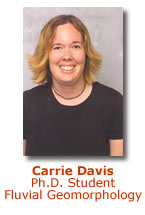Past Environment Research
Dam Removal and River Restoration (1999-2002)Jointly working with the University of Wisconsin's Center for Limnology, Martin Doyle, Jon Harbor, Emily Stanely, John Stofleth, Andy Selle, and Ben Lubbers are working to examine the physical and ecological changes caused by dam removal. Damming of rivers represents one of the most widespread, deliberate impacts of humans on the environment. Dam removals are controversial and managers can only offer subjective information regarding future conditions due to a profound lack of fundamental information on physical and economic impacts. Our work includes two dam removals occurring on the Baraboo River in Lavalle, Wisconsin and the Koshkonong River in Rockdale, Wisconsin. The goals of the study included:
For more information on river restoration and Dam Removal click here.
|
Nonpoint source of E. coli - cows with access to the ditch Watershed Scale Assessments of E. coli Contamination (2000-2003)An interdisciplinary team of scientists from Purdue University's Departments of Agronomy, Political Science, Food Science and Agricultural and Biological Engineering, this project sought to identify the sources of contamination in Lake Shafer from two sub-watersheds. Lake Shafer, an important recreational area in North Central Indiana, had in recent years been plagued by high counts of bacteria, which has resulted in beach closures. Krysten Debroka, Nathan Rice and Lauren Patterson assessed the flow of water from surface runoff and subsurface drains, through sub-watersheds, and identifying the various sources of bacterial contamination including: animal waste, manure application and human waste from septic tanks and treated wastewater. DNA fingerprinting techniques allowed E. coli strains to be matched to their specific sources. The main goal of the project was to present the scientific data to property owners, business owners and farmers in the area so they could address the problem with a minimum of conflict and maximum participation, to arrive at the most equitable and cost effective means of reducing E. coli pollution. In addition, the project aimed to educate local school children in grades 4 through 9 in an effort to reach future stakeholders (see Education Research).
|
Ecosystem Indicators for Urbanizing Midwestern Watersheds (1997-2000)This interdisciplinary project combined stream ecology, fluvial geomorphology, watershed-scale hydrology and water quality modeling, channel scale modeling and land use analysis. The objective was to combine perspectives and techniques from geoscience, civil engineering, stream ecology and GIS to derive and evaluate land use change measures that predict the impact of urbanization on stream ecology. The resulting information would allow watershed managers and planners to approach minimizing environmental impacts in a new, more accessible way by using land use change measures. Faculty involved were Anne Spacie (stream ecology), Jon Harbor (land use change measures and fluvial geomorphology), Midhat Hondzo (in-stream modeling), and Bernie Engel (GIS and watershed modeling). Vickie Poole and Melody Myers-Kinzie were responsible for the field water quality monitoring program, and Martin Doyle handled the geomorphic aspects of this project.
|
The Celery Bog is a wetland in the Cuppy-McClure Watershed Celery Bog/Cuppy-McClure Watershed (1995-2002)Wes Hawthorne and the majority of our lab members have worked on a variety of projects in this local watershed. The site is the focus of the Environmental Geosciences capstone course "Applications of Environmental Geosciences". Major work includes a survey of peat distribution in the wetland, stormwater sampling, geophysical work and assessing the hydrologic impact of land use change. We also worked with Tony Swinehart (former herbarium curator) and Melody Myers-Kinzie (Forestry and Natural Resources) in an attempt to reconstruct the ecological history of the bog from two sample cores. For more information about the Celery Bog, visit the Celery Bog Website.
|
Hydrologic Impacts of Land Use Change Using L-THIA I (1998-2002)Suresh Muthukrishnan, Jon Harbor and several faculty and students in engineering were involved in developing an applications-oriented approach to modeling the impact of land use change on runoff, recharge and water quality, with a particular focus on urban sprawl. Following initial development of a technique for long-term hydrologic impact analysis by Jon Harbor and Keith McClintock, Matt Grove developed a GIS version of the method and performed extensive sensitivity analyses for the approach. Budhendra Bhaduri performed model inter-comparisons and developed a version of the model to assess the cumulative long-term impact of land use change on non-point source pollution at a watershed scale. Marie Minner worked on characterizing the variability of land use change impacts as a function of climate variability on a regional and national scale. Marie also investigated the potential use of hydrologic impact as a way to equitably distribute the tax burden for stormwater management systems. Erin Creasy focused on providing new pollutant build-up data for urban surfaces to be used within the L-THIA-NPS module. An L-THIA users manual for both the basic and GIS approach to L-THIA has been produced. Send us an email if you would like a copy of the manual. Click here to check out L-THIA!
|
|
Trap Efficiency of Stormwater Management Basins and Created Wetlands (1992-2002)We were involved with research regarding the chemical and sediment trap efficiency of constructed wetlands and construction site storm water basins. Previous work includes investigations of the sediment and chemical trap efficiencies of construction site stormwater basins by Dawn Nighman and Budhendra Bhaduri, and an evaluation of the hydrologic performance and trap efficiency of a created wetland on a commercial site by Susan Tatalovich. In order to examine the temporal changes in pollutant trap efficiency of the created wetlands in urban settings over a seasonal and multi-year scale, continuous monitoring of inputs and outputs to several of these systems was required. Vickie Poole and Melody Myers-Kinzie were responsible for the field water quality monitoring program, and Maggie Sullivan focused on understanding nitrate removal in constructed wetlands. |
